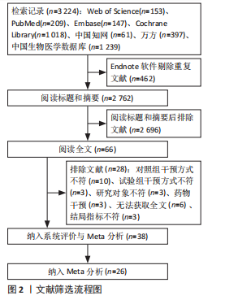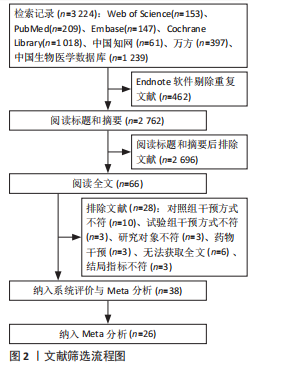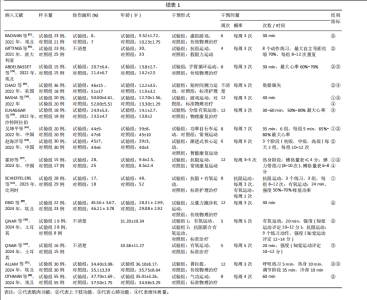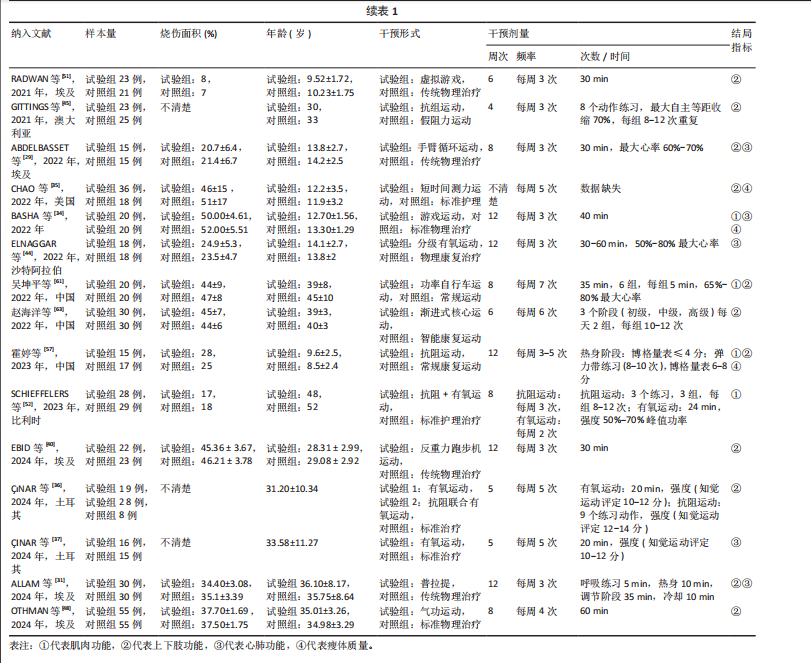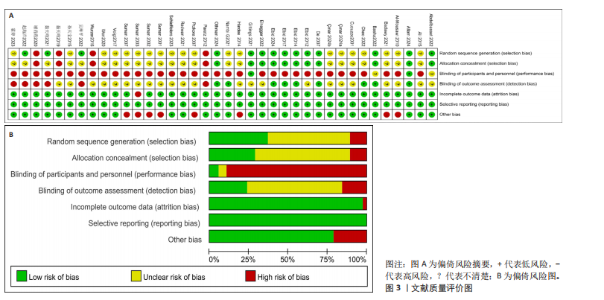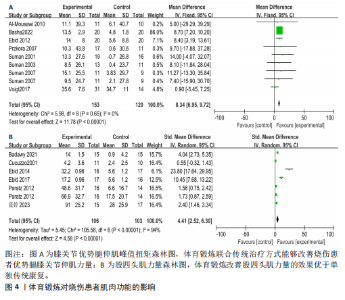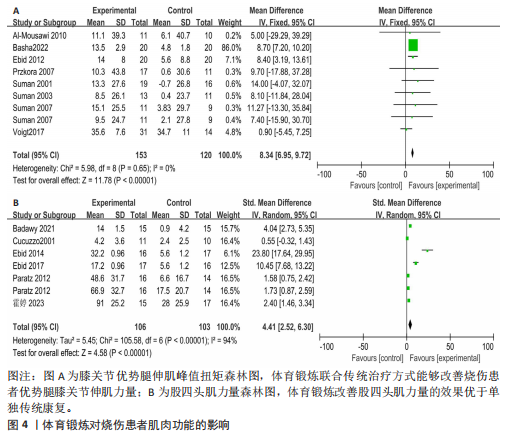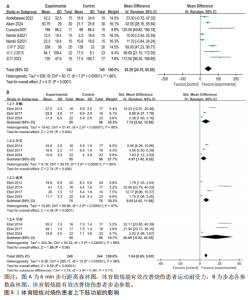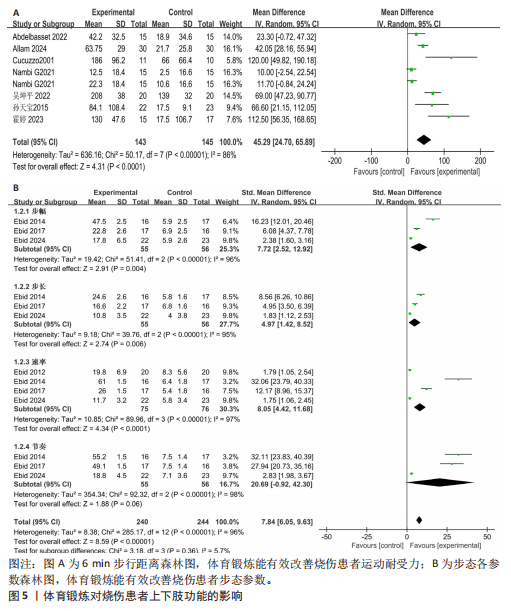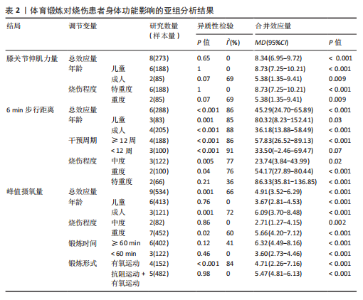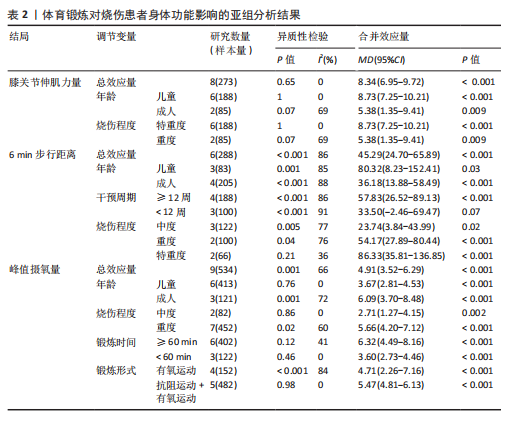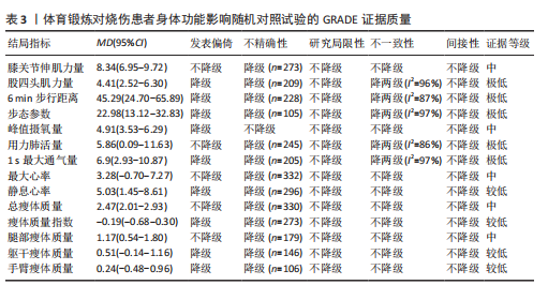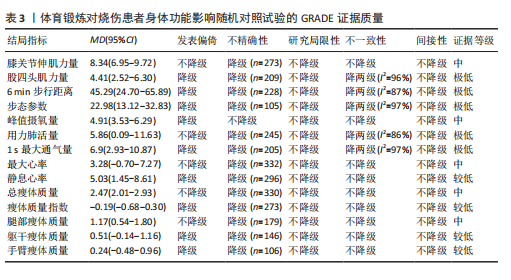Chinese Journal of Tissue Engineering Research ›› 2026, Vol. 30 ›› Issue (5): 1269-1281.doi: 10.12307/2026.016
Previous Articles Next Articles
Physical exercise improves physical function in burn patients: a systematic review and meta-analysis
Chen Qiang1, Wu Wenjuan2, Jiang Shuhua3, Huang Da1
- 1School of Physical Education, 3School of Culture and Media, Jiangxi University of Science and Technology, Nanchang 330098, Jiangxi Province, China; 2School of Physical Education, Nanchang Institute of Science and Technology, Nanchang 330108, Jiangxi Province, China
-
Received:2024-11-26Accepted:2025-01-24Online:2026-02-18Published:2025-06-27 -
Contact:Huang Da, Master, Lecturer, School of Physical Education, Jiangxi University of Science and Technology, Nanchang 330098, Jiangxi Province, China -
About author:Chen Qiang, Master, Associate professor, School of Physical Education, Jiangxi University of Science and Technology, Nanchang 330098, Jiangxi Province, China -
Supported by:Humanities and Social Sciences Research Project of Universities in Jiangxi Province, No. JC23204 (to CQ)
CLC Number:
Cite this article
Chen Qiang, Wu Wenjuan, Jiang Shuhua, Huang Da. Physical exercise improves physical function in burn patients: a systematic review and meta-analysis[J]. Chinese Journal of Tissue Engineering Research, 2026, 30(5): 1269-1281.
share this article
Add to citation manager EndNote|Reference Manager|ProCite|BibTeX|RefWorks
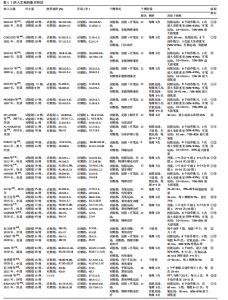
2.2 纳入研究的基本特征 纳入文献的时间跨度为2001-2024年,涉及1 658例患者,其中试验组886例、对照组772例,患者群体包含了儿童与成人。所纳入研究中的运动干预均在训练有素物理治疗师的监督指导下完成。运动形式包括抗阻+有氧运动(15篇)[22-24,32-33,36,38,46,49-50,52-56],单纯抗阻运动(5篇)[41-43,45,57],单纯有氧运动(5篇)[30,37,39,44,60],其他训练形式包括:自行车或跑步机[29,40,61-62]、瑜伽[47]、普拉提[31]、气功[48]、游戏[34,51]、功能性训练[35,58-59]、核心力量训练[63]。纳入文献的基本信息见表1。 2.3 文献质量评价 Cochrane偏倚风险评估结果显示:随机分配中,低风险文献为14篇,20篇为不清楚,4篇为高风险;分配隐藏中,11篇为低风险,23篇为不清楚,4篇为高风险;患者和治疗师施盲中,2篇为低风险,2篇为不清楚,34篇为低风险;结果评估施盲中,9篇为低风险,23篇为不清楚,6篇为高风险;结果数据不完整重,37篇为低风险,1篇为高风险;选择性报告中,38篇为低风险;其他偏倚中,30篇为低风险,8篇为高风险,见图3。 2.4 Meta分析结果 2.4.1 肌肉功能分析 18项研究报告了体育锻炼对烧伤患者肌肉功能改善结果[22-23,32-34,38,41-43,46,49-50,52-53,55-57,61],10项研究报告了273例患者膝关节优势腿伸肌变化,测量单位为峰值扭矩[22-23,32,34,43,46,50,53,55-56],其中2项研究因测量单位不同和基线数据缺失被排除[46,56],最终8项研究被纳入Meta分析[22-23,32,34,43,50,53,55]。合并效应量后发现(I2=0%,P=0.65),表明研究无异质性,采用固定效应模型进行分析,Meta分析结果显示(MD=8.34,95%CI:6.95-9.72,P < 0.000 01),见图4A,表明相较于单独采用传统康复治疗,体育锻炼联合传统治疗方式能够改善烧伤患者优势腿膝关节伸肌力量。 6项研究报道了股四头肌力量变化[33,38,41-42,49,57],合并效应量后发现(I2=94%,P < 0.000 01),表明研究高度异质性,采用随机效应模型进行分析,Meta分析结果显示(SMD=4.41,95%CI:2.52-6.30,P < 0.000 01),见图4B,表明体育锻炼改善股四头肌力量的效果优于单独传统康复。 在其余肌肉力量方面,3项研究报道了握力变化[49,52,57],2项研究报道了髋关节和膝关节屈肌力量[43,52],2项研究报道了下肢爆发力与总做功力[38,41],研究结果表明,参加体育锻炼的干预组在该方面的改善效果均显著优于对照组。在肌肉形态方面,3项研究报道了股四头肌厚度与大小[42,52,61],结果表明体育锻炼的效果显著。 2.4.2 上下肢功能分析 在下肢活动功能中,10项研究通过6 min步行距离指标报道了烧伤患者运动耐受力变化[29,31,35-36,38,47,57,60-62],其中3项研究数据无法提取[35-36,62],最终7项研究被纳入Meta分析[29,31,38,47,57,60-61]。 合并效应量后发现(I2=86%,P < 0.000 01),提示研究高度异质性,采用随机效应模型进行分析,Meta分析结果显示,体育锻炼联合传统治疗方式能够有效改善烧伤患者运动耐受力(MD=45.29,95%CI:24.70-65.89,P < 0.000 1),见图5A。4项研究报道了步态参数变化[40-43],合并效应量后发现(I2=96%,P < 0.000 01),提示研究高度异质性,采用随机效应模型进行分析,Meta分析结果显示,体育锻炼能够有效改善烧伤患者步态参数(SMD=7.84,95%CI:6.05-9.63,P < 0.000 01),包括与步态特征相关的步幅(SMD=7.72,95%CI:2.52-12.92,P=0.004)、步长(SMD=4.97,95%CI:1.42-8.52,P=0.006)、速率(SMD=8.05,95%CI:4.42-11.68,P < 0.000 1),对节奏无无明显改善作用(SMD=20.69,95%CI:-0.92-42.30,P=0.06),见图5B。 2.4.3 心肺功能分析 18项研究报道了体育锻炼改善心肺功能相关结 果[22-24,29-31,34,37,39,44,46-47,49-50,54-56,60],13项研究报道了峰值摄氧量变化[22-23,30,34,39,44,46-49,50,55-56],其中2项研究因无法提取数据被排除[46,49],最终9项研究被纳入Meta分析[22-23,30,34,39,44,50,55-56],合并效应量后发现(I2=66%,P=0.001),显示研究中度异质性,采用随机效应模型进行分析,Meta分析结果显示,体育锻炼能够有效改善烧伤患者的有氧能力(MD=4.91,95%CI:3.52-6.29,P < 0.000 01),见图6A。4项研究报道了用力肺活量变化[24,29,31,60],合并效应量后发现(I2=86%,P < 0.000 1),提示研究高度异质性,采用随机效应模型进行分析,Meta分析结果显示体育锻炼能够有效改善烧伤患者的用力肺活量(MD=5.86,95%CI:0.09-11.63,P=0.05),见图6B。5项研究报道了1 s最大通气量变化[24,29,31,47,60],合并效应量后发现(I2=97%,P < 0.000 01),显示研究高度异质性,采用随机效应模型进行分析,Meta分析结果显示体育锻炼能够有效改善烧伤患者1 s最大通气量(MD=6.90,95%CI:2.93-10.87,P=0.000 7),见图6C。4项研究报道了最大心率变化[39,44,56,60],合并效应量后发现(I2=32%,P=0.21),提示研究低异质性,采用固定效应模型进行分析,Meta分析结果显示,体育锻炼未明显改善烧伤患者最大心率(MD=3.28,95%CI:-0.70-7.27,P=0.11),见图6D。2项研究报道了静息心率变化[39,56],合并效应量后发现(I2=23%,P=0.27),提示研究无异质性,采用固定效应模型进行分析,Meta分析结果显示,体育锻炼能改善烧伤患者静息心率(MD=5.03,95%CI:1.45-8.61,P=0.006),见图6E。此外,与心肺功能相关的指标中,WON等[24]发现抗阻运动能有效改善烧伤患者的咳嗽峰值流量及最大吸气压;ELNAGGAR等[44]发现渐进式有氧运动改善烧患者的分钟通气量、氧脉冲和吸入氧的通气当量;?INAR等[37]发现有氧运动能有效改善炎症标志物,如中性粒细胞-淋巴细胞比率、血小板-淋巴细胞比率和淋巴细胞-单核细胞比率。 2.4.4 瘦体质量分析 10项研究单独报道了烧伤患者总瘦体质量变化[22-23,32-34,41,46,50,53,57],合并效应量后发现(I2=0%,P=0.97),显示研究无异质性,采用固定效应模型进行分析,Meta分析结果显示体育锻炼可明显改善烧伤患者总瘦体质量(MD=2.47,95%CI:2.01-2.93,P < 0.000 01),见图7A。2项研究报道了瘦体质量指数变化[55-56],合并效应量后发现(I2=0%,P=0.95),提示研究无异质性,采用固定效应模型进行分析,Meta分析结果显示体育锻炼未能明显改善烧伤患者瘦体质量指数(MD=-0.19,95%CI:-0.68-0.30,P=0.44),见图7B。5项研究报告了腿部瘦体质量[22-23,34,41,46],合并效应量后发现(I2=0%,P=0.90),提示研究无异质性,采用固定效应模型进行分析,Meta分析结果显示体育锻炼可有效改善烧伤患者腿部瘦体质量(MD=1.17,95%CI:0.54-1.80,P=0.000 3),见图7C。4项研究报告了躯干瘦体质量[22-23,34,46],合并效应量后发现(I2=0%,P=0.99),提示研究无异质性,采用固定效应模型进行分析,Meta分析结果显示体育锻炼未有效改善烧伤患者躯干瘦体质量(MD=0.51,95%CI:-0.14-1.16,P=0.12),见图7C。3项研究报"

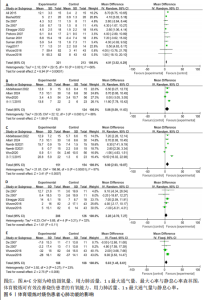
告了手臂瘦体质量[22-23,46],合并效应量后发现(I2=0%,P=0.76),提示研究无异质性,采用固定效应模型进行分析,Meta分析结果显示体育锻炼未有效改善烧伤患者手臂瘦体质量(MD=0.24,95%CI:-0.48-0.96,P=0.51),见图7C。 2.4.5 亚组分析 为探寻不同运动方式、运动剂量对不同烧伤群体的干预效果,此次研究通过对主要结局指标进行亚组分析,包括膝关节伸肌力量、6 min步行距离、峰值摄氧量,划分的依据包括、运动形式、运动周期、单次运动时间,群体划分依据为年龄、烧伤程度。 在膝关节伸肌力量指标中,因研究采用的干预手段方法类似,因此,无法通过干预剂量中的干预时间及周期进行亚组分析。通过年龄及烧伤程度进行亚组分析,划分依据分别为群体(< 18岁为儿童组与≥18岁为成人组),烧伤面积(> 50%为特重度烧伤,30%-50%为重度烧伤组)。通过对年龄与烧伤面积亚组划分发现研究存在一致性。儿童组(188例)同为特重度烧伤组[22-23,32,34,50,53],成人组(85例)为重度烧伤组[43,55],儿童组(特重度烧伤组)Meta分析结果显示,体育锻炼可显著提升烧伤患者膝关节伸肌力量(MD=8.73,95%CI:7.25-10.21,P < 0.001);成人组(重度烧伤组)Meta分析结果显示,体育锻炼可显著提升烧伤患者膝关节伸肌力量(MD=5.38,95%CI:1.35-9.41,P=0.009),见表2。 在6 min步行距离指标中,通过年龄进行亚组划分,儿童组(83例)Meta分析结果显示[29,38,57],体育锻炼可显著提升烧伤患者6 min步行距离(MD=80.32,95%CI:8.32-152.41,P=0.03);成人组(175例)Meta分析结果显示[31,47,60-61],体育锻炼可显著提升烧伤患者6 min步行距离(MD=36.18,95%CI:13.88-58.49,P < 0.001)。根据干预周期划分≥12周组(188例)和< 12周组(100例)[31,38,47, 57,60],≥12周组Meta分析结果显示,体育锻炼可显著提升"
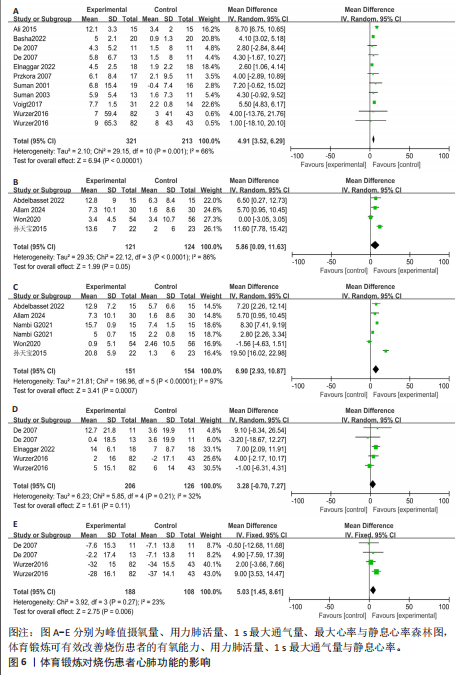
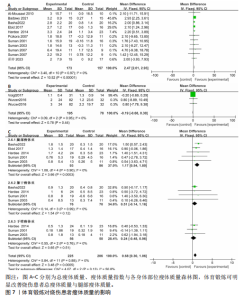
烧伤患者6 min步行距离(MD=57.83,95%CI:26.52-89.13,P < 0.001);< 12周Meta分析结果显示,体育锻炼未能显著提升烧伤患者6 min步行距离(MD=33.5,95%CI:-2.46-69.47,P=0.07)。根据烧伤程度划分成中度组[29,47,57]、重度组[31,61]、特重度组[38,60],中度组Meta分析结果显示,体育锻炼可显著提升烧伤患者6 min步行距离(MD=23.74,95%CI:3.84-43.99,P=0.02);重度组Meta分析结果显示,体育锻炼可显著提升烧伤患者6 min步行距离(MD=54.17,95%CI:27.89-80.44,P < 0.001);特重度组Meta分析结果显示,体育锻炼可显著提升烧伤患者6 min步行距离(MD=86.33,95%CI:35.81-136.85,P < 0.001),见表2。 在峰值摄氧量指标中,主要进行年龄、烧伤程度、锻炼时间、锻炼类型亚组划分。根据年龄划分为儿童组(413例)[22-23,34,44,50,56]、成人组(121例)[30,39,55],儿童组Meta分析结果显示,体育锻炼可显著提升烧伤患者峰值摄氧量(MD=3.67,95%CI:2.81-4.53,P < 0.001);成人组Meta分析结果显示,体育锻炼可显著提升烧伤患者峰值摄氧量(MD=6.09,95%CI:3.70-8.48,P < 0.001)。根据烧伤程度划分为中度组(82例)[39,44]、重度组(452例)[22-23,30,34,50,55-56],中度组Meta分析结果显示,体育锻炼可显著提升烧伤患者峰值摄氧量(MD=2.71,95%CI:1.27-4.15,P=0.002);重度组Meta分析结果显示,体育锻炼可显著提升烧伤患者峰值摄氧量(MD=5.66,95%CI:4.20-7.12,P < 0.001)。根据锻炼时间划分为≥60组(402例)[22-23,30,50,55-56]、< 60 min组(122例)[34,39,44],≥60 min组Meta分析结果显示,体育锻炼可显著提升烧伤患者峰值摄氧量(MD=6.32,95%CI:4.49-8.16,P < 0.001);< 60 min组Meta分析结果显示,体育锻炼可显著提升烧伤患者峰值摄氧量(MD=3.60,95%CI:2.73-4.46,P < 0.001)。根据锻炼类型划分为抗阻联合有氧运动组(482例)[22-23,50,55-56]、单独有氧组(152例)[30,34,39,44],抗阻联合有氧组Meta分析结果显示,体育锻炼可显著提升烧伤患者峰值摄氧量(95%CI:4.81-6.13,P < 0.001);单独有氧组Meta分析结果显示,体育锻炼可显著提升烧伤患者峰值摄氧量(MD=4.71,95%CI:2.26-7.16,P < 0.001),见表2。 2.5 敏感性分析 为检测Meta分析结果的可靠性,通过逐条剔除的方式对主要4个结果(优势腿伸肌力量、6 min步行距离、峰值摄氧量、瘦体质量)进行敏感性分析。优势腿伸肌力量指标中逐个剔除任一研究后得到(MD=6.10-8.71,I2=0%,95%CI:2.39-10.13,P均< 0.001),表明优势腿伸肌力量整体研究结果具备一定的稳定性;6 m步行距离指标中逐个剔除任一研究后得到(MD=39.42-58.68,I2=81%-89%,95%CI:15.65-91.63,P均< 0.001),表明6 min步行距离整体研究结果具备一定的稳定性;峰值摄氧量指标中逐个剔除任一研究后得到(MD=4.27-5.07,I2=39%-69%,95%CI:2.82-6.78,P均< 0.001),表明峰值摄氧量整体研究结果具备一"
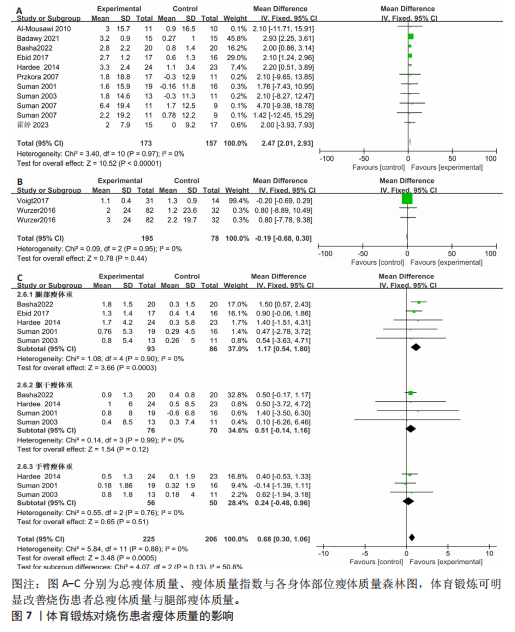

定的稳定性;总瘦体质量中逐个剔除任一研究后得到(MD=2.08-2.56,I2=0%,95%CI:1.46-3.17,P均< 0.001),表明总瘦体质量整体研究结果具备一定的稳定性。 2.6 发表偏倚 此次研究对身体功能的主要指标优势腿膝关节伸肌力量、峰值摄氧量、总瘦体质量进行发表偏倚检测,Egger检验显示膝关节伸肌力量P=0.147,见图8A所示,提示不存在发表偏倚;峰值摄氧量P=0.006,见图8B所示,提示存在发表偏倚;总瘦体质量P=0.201,见图8C所示,提示不存在发表偏倚。 2.7 证据质量评价结果 运用GRADE系统分别对每个指标进行证据质量评价,所有结果推荐的证据质量水平为中等的结果指标有优势腿膝关节伸肌力量、峰值摄氧量、总瘦体质量、腿部瘦体质量、最大心率,质量较低结果指标有静息心率、瘦体质量指数、躯干瘦体质量、手臂瘦体质量,质量极低结果指标有股四头肌力量、6 min步行距离、步态参数、用力肺活量、1 s最大通气量,见表3。通过分析发现多数研究降级的主要原因是不精确性造成,研究的样本量偏少,此外,部分研究降级的因素为不一致性。"

| [1] 郭绍彬,唐世杰,张万聪.1990-2019年中国烧伤发病率及死亡率趋势的年龄-时期-队列模型分析[J].中国美容医学, 2023,32(7):9-13. [2] DA SILVA MMM, TRAVENSOLO CF, PROBST VS, et al. Quantification of changes in functional capacity and muscle strength in patients: a burn intensive care unit cohort study. Burns. 2022;48(4):833-840. [3] VAN AERDE N, MEERSSEMAN P, DEBAVEYE Y, et al. Five-year impact of ICU-acquired neuromuscular complications: a prospective, observational study. Intensive Care Med. 2020;46(6):1184-1193. [4] CLARK AT, SONG J, YAO X, et al. Muscle Homeostasis Is Disrupted in Burned Adults. J Burn Care Res. 2020;41(1):33-40. [5] OZKAL O, YURDALAN SU, SEYYAH M, et al. The effect of burn severity on functional capacity in patients with burn injury. J Back Musculoskelet Rehabil. 2019;32(2):215-221. [6] SPRONK I, LEGEMATE CM, POLINDER S, et al. Health-related quality of life in children after burn injuries: A systematic review. J Trauma Acute Care Surg. 2018;85(6):1110-1118. [7] CUIJPERS MD, BAARTMANS MGA, VAN ZUIJLEN PPM, et al. Children’s growth and motor development following a severe burn: a systematic review. Burns Trauma. 2023;11:tkad011. [8] POLYCHRONOPOULOU E, HERNDON DN, PORTER C. The Long-Term Impact of Severe Burn Trauma on Musculoskeletal Health. J Burn Care Res. 2018;39(6):869-880. [9] ARGILÉS JM, CAMPOS N, LOPEZ-PEDROSA JM, et al. Skeletal Muscle Regulates Metabolism via Interorgan Crosstalk: Roles in Health and Disease. J Am Med Dir Assoc. 2016;17(9):789-796. [10] GUPTA K, MEHROTRA M, KUMAR P, et al. Smoke Inhalation Injury: Etiopathogenesis, Diagnosis, and Management. Indian J Crit Care Med. 2018;22(3):180-188. [11] JESCHKE MG, CHINKES DL, FINNERTY CC, et al. Pathophysiologic response to severe burn injury. Ann Surg. 2008;248(3):387-401. [12] ELNAGGAR RK, OSAILAN AM, MAHMOUD WS, et al. Beyond the Acute Phase: Understanding Relationships Among Cardiorespiratory Response to Exercises, Physical Activity Levels, and Quality of Life in Children After Burn Injuries. J Burn Care Res. 2022;43(4):827-833. [13] SULLI D, DHOPTE A, AGRAWAL K. Impact of burn contractures of chest wall and their surgical release on pulmonary function. Burns. 2019;45(4):929-935. [14] KANBAY M, SIRIOPOL D, COPUR S, et al. Effect of Bimagrumab on body composition: a systematic review and meta-analysis. Aging Clin Exp Res. 2024;36(1):185. [15] 伍朝明,孙君志.下肢抗阻训练对老人步行能力及平衡能力影响的Meta分析[J].中国组织工程研究,2021,25(26):4257-4264. [16] DOMBRECHT D, VAN DAELE U, VAN ASBROECK B, et al. Molecular mechanisms of post-burn muscle wasting and the therapeutic potential of physical exercise. J Cachexia Sarcopenia Muscle. 2023;14(2): 758-770. [17] 霍婷,徐向阳,谢卫国,等.运动康复训练在小儿烧伤康复中应用的研究进展[J].中华烧伤与创面修复杂志,2023, 39(3):275-279. [18] FLORES O, TYACK Z, STOCKTON K, et al. Exercise training for improving outcomes post-burns: a systematic review and meta-analysis. Clin Rehabil. 2018;32(6):734-746. [19] GITTINGS PM, GRISBROOK TL, EDGAR DW, et al. Resistance training for rehabilitation after burn injury: A systematic literature review & meta-analysis. Burns. 2018;44(4): 731-751. [20] 杨莎,邱林.抗阻训练对烧伤患儿康复效果影响的研究进展[J].中华烧伤杂志, 2021,37(9):895-899. [21] YANG S, QIU L, XIAO J, et al. The effects of resistance training on children with burns: a meta-analysis. Pediatr Surg Int. 2021;37(10):1323-1332. [22] SUMAN OE, SPIES RJ, CELIS MM, et al. Effects of a 12-wk resistance exercise program on skeletal muscle strength in children with burn injuries. J Appl Physiol (1985). 2001;91(3):1168-1175. [23] SUMAN OE, THOMAS SJ, WILKINS JP, et al. Effect of exogenous growth hormone and exercise on lean mass and muscle function in children with burns. J Appl Physiol (1985). 2003;94(6):2273-2281. [24] WON YH, CHO YS, JOO SY, et al. The effect of a pulmonary rehabilitation on lung function and exercise capacity in patients with burn: a prospective randomized single-blind study. J Clin Med. 2020;9(7):2250. [25] 邱卓英,王朴,王博.《国际功能、残疾和健康分类》的发展和应用进展[J].中国康复理论与实践,2008(1):85-86. [26] 王国祥,姜静远,邱卓英,等.康复体育政策架构、优先领域及其核心内容:基于WHO康复政策内容分析[J].中国康复理论与实践,2022,28(12):1380-1389. [27] 刘兴朝,胡通,马艳,等.康复机器人训练脑性瘫痪患者:改善下肢运动功能效果的Meta分析[J].中国组织工程研究, 2025,29(18):3925-3933. [28] PAGE MJ, MOHER D, BOSSUYT PM, et al. PRISMA 2020 explanation and elaboration: updated guidance and exemplars for reporting systematic reviews. BMJ. 2021; 372:n160. [29] ABDELBASSET WK, ELSAYED SH, NAMBI G, et al. Optimization of pulmonary function, functional capacity, and quality of life in adolescents with thoracic burns after a 2-month arm cycling exercise programme: a randomized controlled study. Burns. 2022;48(1):78-84. [30] ALI ZM, EL-REFAY BH, ALI RR. Aerobic exercise training in modulation of aerobic physical fitness and balance of burned patients. J Phys Ther Sci. 2015;27(3):585-589. [31] ALLAM NM, BADAWY MM, ELIMY DA. Effect of Pilates exercises on pulmonary function, respiratory muscle strength, and functional capacity in patients with inhalation injury after flame thermal burn: a prospective randomized controlled trial. Burns. 2024; 50(9):107284. [32] AL-MOUSAWI AM, WILLIAMS FN, MLCAK RP, et al. Effects of exercise training on resting energy expenditure and lean mass during pediatric burn rehabilitation. J Burn Care Res. 2010;31(3):400-408. [33] BADAWY MM, ALLAM NM. Impact of Adding Protein Supplementation to Exercise Training on Lean Body Mass and Muscle Strength in Burn Patients. J Burn Care Res. 2021;42(5):968-974. [34] BASHA MA, ABOELNOUR NH, ALY SM, et al. Impact of Kinect-based virtual reality training on physical fitness and quality of life in severely burned children: a monocentric randomized controlled trial. Ann Phys Rehabil Med. 2022;65(1):101471. [35] CHAO T, PARRY I, PALACKIC A, et al. The effects of short bouts of ergometric exercise for severely burned children in intensive care: A randomized controlled trial. Clin Rehabil. 2022;36(8):1052-1061. [36] ÇINAR MA, BAYRAMLAR K, ERKILIC A, et al. Effect of three different exercise trainings on functional capacity in early stage severe burn patients: a randomized controlled trial. Ulus Travma Acil Cerrahi Derg. 2024; 30(8):562-270. [37] ÇINAR MA, ERKILIÇ A. Effect of aerobic exercise on neutrophil-lymphocyte ratio, platelet-lymphocyte ratio, and lymphocyte-monocyte ratio in burn patients: a randomized controlled trial. J Plast Reconstr Aesthet Surg. 2024;95:199-206. [38] CUCUZZO NA, FERRANDO A, HERNDON DN. The effects of exercise programming vs traditional outpatient therapy in the rehabilitation of severely burned children. J Burn Care Rehabil. 2001;22(3):214-220. [39] DE LATEUR BJ, MAGYAR-RUSSELL G, BRESNICK MG, et al. Augmented exercise in the treatment of deconditioning from major burn injury. Arch Phys Med Rehabil. 2007;88(12 Suppl 2):S18-23. [40] EBID AA, ATTALLA AF, IBRAHIM AR, et al. Effect of anti-gravity treadmill (Alter G) training on gait characteristics and postural stability in adult with healed burns: a single blinded randomized controlled trial. Burns. 2024;50(1):106-114. [41] EBID AA, EL-SHAMY SM, AMER MA. Effect of vitamin D supplementation and isokinetic training on muscle strength, explosive strength, lean body mass and gait in severely burned children: a randomized controlled trial. Burns. 2017;43(2):357-365. [42] EBID AA, EL-SHAMY SM, DRAZ AH. Effect of isokinetic training on muscle strength, size and gait after healed pediatric burn: a randomized controlled study. Burns. 2014;40(1):97-105. [43] EBID AA, OMAR MT, ABD EL BAKY AM. Effect of 12-week isokinetic training on muscle strength in adult with healed thermal burn. Burns. 2012;38(1):61-68. [44] ELNAGGAR RK, OSAILAN AM, ALSUBAIE SF, et al. Graded aerobic exercise (GAEx): an effective exercise regimen to improve cardio-respiratory fitness and physical and psychosocial functioning in children with burn sequelae of the chest. Burns. 2022;48(2):337-344. [45] GITTINGS PM, WAND BM, HINCE DA, et al. The efficacy of resistance training in addition to usual care for adults with acute burn injury: a randomised controlled trial. Burns. 2021;47(1):84-100. [46] HARDEE JP, PORTER C, SIDOSSIS LS, et al. Early rehabilitative exercise training in the recovery from pediatric burn. Med Sci Sports Exerc. 2014;46(9):1710-1716. [47] NAMBI G, ABDELBASSET WK, ELSHEHAWY AA, et al. Yoga in Burn: role of pranayama breathing exercise on pulmonary function, respiratory muscle activity and exercise tolerance in full-thickness circumferential burns of the chest. Burns. 2021;47(1): 206-214. [48] OTHMAN EM, TOSON RA. Response of bone mineral density and balance performance in post-burn patients with selected Qigong training: a single-blind randomized controlled trial. Burns. 2024;50(2):495-506. [49] PARATZ JD, STOCKTON K, PLAZA A, et al. Intensive exercise after thermal injury improves physical, functional, and psychological outcomes. J Trauma Acute Care Surg. 2012;73(1):186-194. [50] PRZKORA R, HERNDON DN, SUMAN OE. The effects of oxandrolone and exercise on muscle mass and function in children with severe burns. Pediatrics. 2007;119(1):e109-116. [51] RADWAN NL, IBRAHIM MM, MAHMOUD WS. Effect of Wii-habilitation on spatiotemporal parameters and upper limb function post-burn in children. Burns. 2021;47(4):828-837. [52] SCHIEFFELERS DR, DOMBRECHT D, LAFAIRE C, et al. Effects of exercise training on muscle wasting, muscle strength and quality of life in adults with acute burn injury. Burns. 2023;49(7):1602-1613. [53] SUMAN OE, HERNDON DN. Effects of cessation of a structured and supervised exercise conditioning program on lean mass and muscle strength in severely burned children. Arch Phys Med Rehabil. 2007;88(12 Suppl 2):S24-29. [54] SUMAN OE, MLCAK RP, HERNDON DN. Effect of exercise training on pulmonary function in children with thermal injury. J Burn Care Rehabil. 2002;23(4):288-293; discussion 287. [55] VOIGT CD, FONCERRADA G, PEÑA R, et al. Effects of Community-Based Exercise in Adults With Severe Burns: a Randomized Controlled Trial. Arch Phys Med Rehabil. 2020;101(1S):S36-S41. [56] WURZER P, VOIGT CD, CLAYTON RP, et al. Long-term effects of physical exercise during rehabilitation in patients with severe burns. Surgery. 2016;160(3):781-788. [57] 霍婷,阮晶晶,蒋梅君,等.居家弹力带抗阻训练对严重烧伤患儿肌肉功能和步行能力影响的前瞻性研究[J].中华烧伤与创面修复杂志,2023,39(12):1131-1139. [58] 茹天峰,李菲虹,谢卫国,等.平衡训练联合常规治疗对严重烧伤后下肢运动及平衡功能障碍患者影响的前瞻性随机对照研究[J].中华烧伤杂志,2021,37(4): 312-318. [59] 茹天峰,李菲虹,袁林,等.阿基米德悬吊系统在深度烧伤后膝关节屈曲功能障碍康复中的临床效果[J].中华烧伤杂志, 2019,35(6):428-433. [60] 孙天宝,郭钦,王俊,等.有氧训练对大面积烧伤患者康复早期心肺功能的影响[J].中国康复医学杂志,2015,30(2):182-184. [61] 吴坤平,陈佩,茹天峰,等.功率自行车康复训练对大面积烧伤致下肢功能障碍患者股四头肌和步行能力影响的前瞻性随机对照研究[J].中华烧伤与创面修复杂志,2022,38(5):447-453. [62] 谢肖霞,刘付明英,彭冲,等.早期卧位踏车训练对下肢重度烧伤患者的效果[J].中国康复理论与实践,2020,26(5):603-606. [63] 赵海洋,刘佳琦,韩军涛,等.渐进式核心肌群训练联合下肢智能康复训练对烧伤患者下肢功能障碍影响的前瞻性随机对照研究[J].中华烧伤与创面修复杂志, 2022,38(12):1117-1125. [64] KONOPKA AR, ASANTE A, LANZA IR, et al. Defects in mitochondrial efficiency and H2O2 emissions in obese women are restored to a lean phenotype with aerobic exercise training. Diabetes. 2015; 64(6):2104-2115. [65] RIVAS E, HERNDON DN, CAMBIASO-DANIEL J, et al. Quantification of an Exercise Rehabilitation Program for Severely Burned Children: The Standard of Care at Shriners Hospitals for Children®-Galveston. J Burn Care Res. 2018;39(6): 889-896. [66] 胡玲玉.功率自行车对脑卒中偏瘫患者下肢肌张力及平衡功能的影响[J].医疗装备,2020,33(1):193-194. [67] LEE SY, SEO J, SEO CH, et al. Gait Performance and Brain Activity Are Improved by Gait Automatization during Robot-Assisted Gait Training in Patients with Burns: A Prospective, Randomized, Single-Blinded Study. J Clin Med. 2024; 13(16):4838. [68] CAMBIASO-DANIEL J, RIVAS E, CARSON JS, et al. Cardiorespiratory Capacity and Strength Remain Attenuated in Children with Severe Burn Injuries at Over 3 Years Postburn. J Pediatr. 2018;192:152-158. [69] RIVAS E, HERNDON DN, BECK KC, et al. Children with Burn Injury Have Impaired Cardiac Output during Submaximal Exercise. Med Sci Sports Exerc. 2017; 49(10):1993-2000. [70] CLAYTON RP, WURZER P, ANDERSEN CR, et al. Effects of different duration exercise programs in children with severe burns. Burns. 2017;43(4):796-803. [71] TAPKING C, POPP D, HERNDON DN, et al. Cardiovascular Effect of Varying Interval Training Frequency in Rehabilitation of Severely Burned Children. J Burn Care Res. 2019;40(1):34-38. [72] PALACKIC A, SUMAN OE, PORTER C, et al. Rehabilitative Exercise Training for Burn Injury. Sports Med. 2021;51(12):2469-2482. |
| [1] | Liu Yu, Lei Senlin, Zhou Jintao, Liu Hui, Li Xianhui. Mechanisms by which aerobic and resistance exercises improve obesity-related cognitive impairment [J]. Chinese Journal of Tissue Engineering Research, 2026, 30(5): 1171-1183. |
| [2] | Tao Yunfei, Peng Li. Acute effects of blood flow restriction in low-intensity resistance training on endothelial function-related inflammatory factors [J]. Chinese Journal of Tissue Engineering Research, 2026, 30(5): 1184-1195. |
| [3] | Li Hanyue, Li Yini, Xiang Linmei, Li Sen. Effects of resistance exercise therapy on pain and function in patients with cervical spondylotic radiculopathy: a meta-analysis [J]. Chinese Journal of Tissue Engineering Research, 2026, 30(4): 987-996. |
| [4] | Zeng Hao, Sun Pengcheng, Chai Yuan, Huang Yourong, Zhang Chi, Zhang Xiaoyun. Association between thyroid function and osteoporosis: genome-wide data analysis of European populations [J]. Chinese Journal of Tissue Engineering Research, 2026, 30(4): 1019-1027. |
| [5] | Zhao Xiaoxuan, Liu Shuaiyi, Li Qi, Xing Zheng, Li Qingwen, Chu Xiaolei. Different exercise modalities promote functional recovery after peripheral nerve injury [J]. Chinese Journal of Tissue Engineering Research, 2025, 29(6): 1248-1256. |
| [6] | Ji Long, Chen Ziyang, , Jin Pan, Kong Xiangkui, Pu Rui, . Lipophagy, exercise intervention and prevention and treatment of nonalcoholic fatty liver disease [J]. Chinese Journal of Tissue Engineering Research, 2025, 29(35): 7611-7619. |
| [7] | Zhang Xiaoyu, Wei Shanwen, Fang Jiawei, Ni Li. Prussian blue nanoparticles restore mitochondrial function in nucleus pulposus cells through antioxidation [J]. Chinese Journal of Tissue Engineering Research, 2025, 29(34): 7318-7325. |
| [8] | Yao Tingfeng, Liu Lin, Liu Shixuan, Lu Xinyue. Meta-analysis of the effectiveness of dry needling at myofascial trigger points in the treatment of knee disorders [J]. Chinese Journal of Tissue Engineering Research, 2025, 29(32): 6989-6996. |
| [9] | Wang Jiaqian, , Jiang Changjun, Peng Yi, Ma Mi, Li Junhan. Study on the role of aerobic exercise in regulating the CNPY2-mediated AKT/GSK3β pathway for improving non-alcoholic fatty liver [J]. Chinese Journal of Tissue Engineering Research, 2025, 29(30): 6441-6448. |
| [10] | Wang Xuesong, Wang Yue, Xu Yan, Zeng Wenhui, Lu Wenming, Tang Xingkun, Chen Wenjie, Ye Junsong. Brain-computer interface combined with different therapies for limb dysfunction in stroke patients: effectiveness and mechanism analysis [J]. Chinese Journal of Tissue Engineering Research, 2025, 29(30): 6538-6546. |
| [11] | Wang He, Yu Shaohong, . Meta-analysis of transcranial direct current stimulation in improving lower limb motor dysfunction in stroke patients [J]. Chinese Journal of Tissue Engineering Research, 2025, 29(30): 6556-6565. |
| [12] | Liu Haowei, Tian Haodong, Huang Li, Yu Hanglin, Peng Li. Acute effects of blood flow restriction resistance exercise on serum metabolites in obese young men [J]. Chinese Journal of Tissue Engineering Research, 2025, 29(29): 6249-6259. |
| [13] | Jiang Siqi, Huang Huanhuan, Yu Xinyu, Peng Ying, Zhou Wei, Zhao Qinghua. Meta-analysis of dose-effect of exercise on improving muscle health in community-dwelling older adults with sarcopenia [J]. Chinese Journal of Tissue Engineering Research, 2025, 29(29): 6295-6304. |
| [14] | He Ningjuan, Li Li, Wang Su, Yang Jianshe, Lei Siyun, Wang Yang. Effects of aerobic or resistance exercise on hippocampal ras/Drebrin dendritic spine plasticity in a mouse model of Alzheimer’s disease [J]. Chinese Journal of Tissue Engineering Research, 2025, 29(26): 5528-5535. |
| [15] | Nan Songhua, Peng Chaojie, Cui Yinglin. Mitochondrial dysfunction and brain aging: a bibliometrics analysis based on the Web of Science Core Collection database [J]. Chinese Journal of Tissue Engineering Research, 2025, 29(26): 5642-5651. |
| Viewed | ||||||
|
Full text |
|
|||||
|
Abstract |
|
|||||
